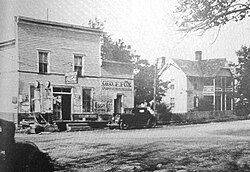Loyston, Tennessee
| Loyston, Tennessee | |
|---|---|
| Ghost town | |

Filling station in Loyston, 1933
|
|
| Coordinates: 36°15′55″N 83°57′00″W / 36.26528°N 83.95000°WCoordinates: 36°15′55″N 83°57′00″W / 36.26528°N 83.95000°W | |
| Country | United States |
| State | Tennessee |
| County | Union |
| Elevation | 1,020 ft (310 m) |
| Time zone | Eastern (EST) (UTC-5) |
| • Summer (DST) | EDT (UTC-4) |
| GNIS feature ID | 1311794 |
Loyston is a ghost town in Union County, Tennessee, United States, that was inundated by the waters of the Clinch River after the completion of Norris Dam in 1936. Established in the early 19th century around a foundry built by its namesake, John Loy, over subsequent decades the community's location along State Highway 61 helped it grow into a trading center for local farmers. By the time the Tennessee Valley Authority (TVA) began making plans to build Norris Dam in the early 1930s, Loyston had a population of approximately 70 residents, and consisted of a post office and several small businesses.
Prior to inundation, TVA conducted extensive sociological surveys of Loyston's residents, and the community was documented by photographer Lewis Hine. Most of Loyston's residents relocated elsewhere in the area, with many forming the community of New Loyston in the hills to the south. Loyston was located near where Mill Creek empties into the Clinch River, at river mile 98. Mill Creek's drainage carved a broad valley known as Big Valley, flanked on the south by Lone Mountain and on the east by Big Ridge. At Loyston, State Highway 61 intersected a major local road. The trip to Knoxville from Loyston was a 30-mile (48 km) drive on Highway 61 (which has since been re-routed).
Loyston is now under a mile-wide section of Norris Lake known as the "Loyston Sea," located along the shores of Big Ridge State Park.
In the 1780s, German immigrant Henry Sharp built a frontier fort known as "Sharp's Station" on the slopes of Big Ridge overlooking the Clinch River east of Loyston, the area having been identified by long hunters travelling down the Clinch Valley during the previous decade. In 1933, Sharp's descendants were still prominent members of the Loyston community, evidenced by names such as "Sharp's Station Methodist Episcopal Church," which was located just outside Loyston. Another notable early settler, Robert Stooksbury, moved to the Loyston area around 1800. Several dozen of Stooksbury's descendants were still living in the Loyston area in the early 1930s, some of whom operated one of the community's general stores.
...
Wikipedia

